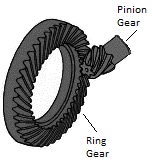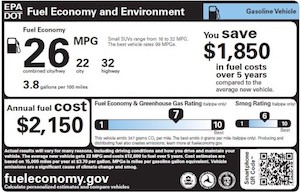A gear ratio is calculated by dividing the number of teeth of the driving gear by the number of teeth of the driven gear.
Rear End Gear Ratio Calculator
Axle ratio or rear end gear ratio is calculated by dividing the number of teeth on the ring gear by the number of teeth on the pinion gear. This gear ratio calculation is used by our diff gear calculator. Most differentials nowadays will have a sticker on the outside with axle ratio information. That way you don’t have to take apart a differential and manually count the teeth on the gears just to calculate axle ratio.
Gear Ratio Calculator

If your vehicle doesn’t have a sticker or it has worn off there is another method for roughly calculating the axle ratio. You will have to put the vehicle on a hoist or jack stands so that the tires are in the air and then mark the axle and the driveshaft. While spinning the tire one complete rotation count how many spins the axle does. This should give you a rough idea, and then you can estimate based on common axle ratios. For instance, common axle ratios for Toyota Trucks are 4.10, 4.56, 4.88, and 5.29 so if you counted almost 5 rotations then it is likely a 5.88:1 axle ratio. It is also becoming increasingly easier to find mechanical information such as axle ratio online. However, use care because if the differential is not the stock standard option then you may have to manually calculate it.
What is Axle Ratio?
Axle ratio refers to the number of rotations that the driveshaft completes over one full turn of the axle. This value represents the difference in teeth number of the gears in the differential. Take for instance a gear ratio of 4.11, that means that the driveshaft turns 4.11 rotations for 1 rotation of the axle. This is formally expressed as 4.11:1 because it is a ratio but is often referred to just as 4.11 or “four eleven”. If you want more information on differentials see our page on how differentials work
Why is Axle Ratio important?
Axle ratio is an important factor to consider, irregardless of whether you’re looking at four-wheel drive, all-wheel drive, rear-wheel drive or front-wheel drive. Axle ratio determines the fuel economy, torque, and towing capacity, so be sure to assess the axle ratio before buying a truck or vehicle. Higher axle ratios correspond to increased torque and towing capacity but with the drawback of a lower top speed and decreased fuel economy. The increased fuel consumption comes from higher rpms because the driveshaft must turn more to complete a full rotation of the axle. Lower axle ratios sacrifice some of the torque resulting in reduced towing capacity but also increased fuel economy. Lower numerical values for gear ratio are sometimes referred to as “tall” gears and larger axle ratios as “short” gears, and while this may seem confusing there is an easy way to remember this. Tall people have a longer stride length and can cover more distance per step, just like a “tall” axle ratio gets further with each rotation of the driveshaft. Vehicles with “tall” gear ratios produce better gas mileage because the lower rpm at given speeds, but that lower rpm reduces the torque and therefore towing capacity.

What axle ratio is best for you?
If your vehicle will be used more for commuting and daily driving then having higher fuel efficiency will likely be more important and a lower axle ratio would be best. However, if you will be towing or require more torque then a higher axle ratio is required. It is common for people to upgrade their differentials to a higher axle ratio for performance benefits. For off-roading a higher axle ratio means more torque at low speeds to be able to maneuver over more difficult terrain, and the lower top speed or fuel economy is not usually an issue. Another instance where a higher axle ratio is beneficial is for vehicles built for sprint or drag races, where they need lots of initial power and acceleration.
Important Considerations for Axle Ratio
The United States Environmental Protection Agency (EPA) sets fuel economy information for vehicles primarily based on the standard axle ratio so the information displayed on the window sticker might be incorrect even if the vehicle can come with other optional axle ratios. For more information on the stickers or the regulations around fuel economy visit the EPA’s website

Another point to consider is that differences in axle ratio and the associated effect on towing and fuel economy cannot necessarily be compared across manufacturers or even different models. This is because there are other factors such as tire size that ultimately influence the ratio because the tire acts as one big gear at the end of the system. The gearing of the transmission will also affect the axle ratio and ultimately the fuel economy and towing capacity as well because it will change the revolutions of the axle at a given rpm.
If you would like to learn more about how your vehicle works and wears, check out our other blog articles:
How Differentials Work: How Complicated Can It Be?
New Ring and Pinion Gear Set Break-In
